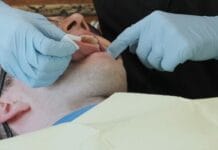A study led by researchers from the University of Washington for the first time has comprehensively identified and classified how individuals respond differently to biofilm accumulation. Additionally, they found a previously unrecognized host protective mechanism that prevents inflammatory bone loss during the reversible stage of gingival inflammation, gingivitis.1
Unchecked biofilm can pave the way for gingivitis, causing gingival inflammation, which can, in turn, progress to periodontitis. Beyond dental concerns, chronic inflammation resulting from biofilm can have systemic health implications, including associations with heart disease, diabetes, cancer, arthritis, and GI diseases.1
The Study
To thoroughly investigate how people respond to experimental gingivitis, the study induced reversible biofilm-induced gingival inflammation. The study population included 21 healthy adults aged 18 to 35 with healthy gingiva and no signs of gingivitis.1
The study consisted of three phases: a two-week pre-induction phase with normal hygiene, a three-week induction phase to induce gingivitis, and a two-week resolution phase. At each phase, 42 samples were taken for a total of 336 samples. During the induction phase, participants used customized intraoral stents to prevent accidental brushing of experimental sites.1
Standard measures were used, like the gingival index (GI) and bleeding on probing (BOP) to assess gingival inflammation, while the plaque index (PI) helped determine bacteria/biofilm accumulation on teeth. As expected, all participants showed biofilm accumulation and gingival inflammation.1
Participants were grouped based on how their gingival health changed over time in response to biofilm accumulation from day zero to day 21. Participants were then split into three groups: high, low, and slow responders, making up 28.6%, 28.6%, and 42.9% of participants, respectively.1
Each group had different numbers of participants: six in the high and low responder groups and nine in the slow responder group. No significant differences in age or gender between these groups were identified.1
The Results
This study not only confirmed two known oral inflammation phenotypes – high clinical response and low clinical response – but has introduced a third, termed the “slow” phenotype. This discovery indicates a delayed yet robust inflammatory reaction when confronted with biofilm accumulation.1
Moreover, the research highlights a diverse range of inflammatory responses exhibited by subjects with low clinical responses, spanning various inflammation signals. Dr. Richard Darveau from the UW School of Dentistry remarked, “This study has revealed a heterogeneity in the inflammatory response to bacterial accumulation that has not been described previously.”2
Dr. Jeffrey McLean, another author of the study, added, “We found a particular group of people that have a slower development of plaque as well as a distinct microbial community makeup before the start of the study.” This knowledge could aid in identifying individuals at higher risk of periodontitis and potentially extend to understanding susceptibility to other bacterial-associated inflammatory conditions, such as inflammatory bowel disease.2
Furthermore, the researchers uncovered a unique protective mechanism initiated by the body in response to biofilm accumulation, which safeguards tissue and bone during inflammation. This mechanism, observed in all three phenotypes, involves neutrophils acting as vigilante sentinels in the mouth, regulating bacterial populations to maintain a state of healthy homeostasis. Surprisingly, the right amount and composition of biofilm are crucial for supporting normal tissue function.1
Studies involving mice have demonstrated that biofilm provides a pathway for neutrophils to migrate from the bloodstream through the gingival tissue into the gingival sulcus. In this state of equilibrium, neutrophils promote colonization resistance. This protective inflammatory response helps fend off excessive harmful bacteria and resist infection while preserving normal periodontal bone and tissue function.1
Conclusion
The researchers state, “Understanding this human variation in gingival inflammation may facilitate the identification of periodontitis-susceptible individuals. Overall, this study underscores the variability in host responses in the human population arising from variations in host immune profiles (low responders) and microbial community maturation (slow responders) that may impact clinical outcomes in terms of destructive inflammation.”1
These findings emphasize the importance of the age-old advice from dentists and dental hygienists: regular brushing and interdental cleaning to prevent excessive biofilm accumulation. Dr. Darveau explained, “The idea of oral hygiene is to recolonize the tooth surface with appropriate bacteria that participate with the host inflammatory response to keep unwanted bacteria out.”2 The process of bacteria repopulating the mouth’s surfaces begins spontaneously and almost immediately, contributing to oral health maintenance.1,2
It should be noted that while this study has several strengths, including many of the findings reaching a high level of statistical significance, the researchers point out that despite 336 total samples, the small sample size is a limitation. Further research to replicate the results is recommended.1
The researchers conclude, “Collectively, these findings pave the way for more attention to be paid to individual differences in both the microbial composition and host response to more fully understand bacterial dysbiosis-driven diseases.”1
Before you leave, check out the Today’s RDH self-study CE courses. All courses are peer-reviewed and non-sponsored to focus solely on pure education. Click here now.
Listen to the Today’s RDH Dental Hygiene Podcast Below:
References
- Bamashmous, S., Kotsakis, G.A., Kerns, K.A., et al. Human Variation in Gingival Inflammation. Proceedings of the National Academy of Sciences of the United States of America. 2021; 118(27): e2012578118. https://doi.org/10.1073/pnas.2012578118
- University of Washington School of Dentistry. (2021, July 14). Study Reveals New Aspects of Gingivitis and the Body’s Response. ScienceDaily. www.sciencedaily.com/releases/2021/07/210714110501.htm










